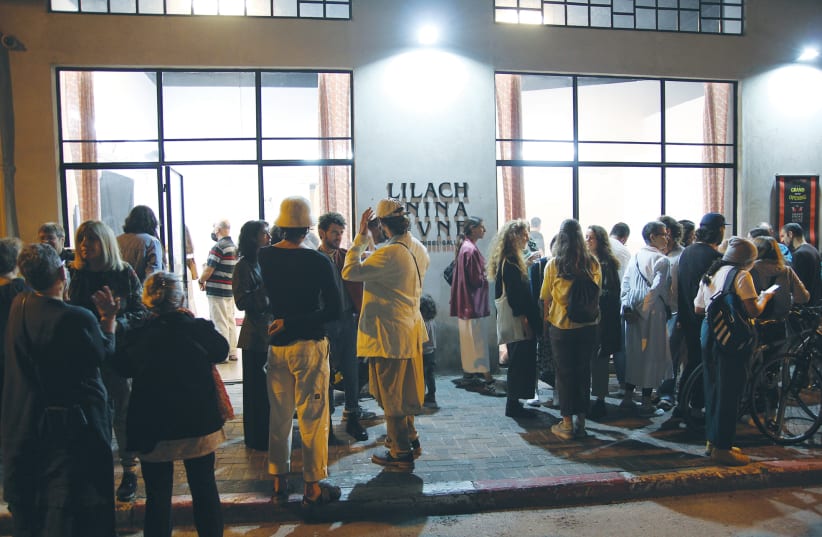Dozens of dancers, artists, friends and fans gathered to visit the latest addition to the re-awakened art scene with cultural events returning to full swing after a year of COVID-19 restrictions. Livne, with her proud mother – writer Hanna Livne – sitting by her side, added to the merriment by leading the crowd in a recreation of a TikTok challenge. To sit comfortably on the floor, clench the base of a wine glass between one’s teeth, arch the back backwards and offer the drink to a close friend sitting behind them. There is a trick involved, the wine glasses are made out of light plastic. Some people got a little wet but many enjoyed the unusual experience.
This unusual way of doing things typifies the sort of explorations Livne is famous, admired for even. Many are used to imagining ballet, or modern dance, as a highly demanding stage-art where beautiful people do nearly impossible things with their bodies. The trauma and stress lurking beneath the surface were explored in the 2010 film Black Swan with Natalie Portman, who relied on Sarah Lane as her dance double for the production. The recent death of Liam Scarlett, a brilliant choreographer who was accused of sexual misconduct towards his students, illustrates the pain which often accompanies professional dancing. In contrast, Livne led dancing experiments where both male and female dancers wore burkas and attempted to find how does it feel to perform when a body is fully covered. Does the audience “get” something? If so, what? This turns a very established trope in our modern culture on its head. Imagine Degas arriving to paint young female dancers at class only to find them fully covered.
Wearing gold-painted clothes, gold earrings and gold shoes, dancer Ofir Siman-Tov shares how he donned a burka himself at Rabin Square thanks to Livne in 2013. The gold, he tells me, is homage to the 2015 Israeli Eurovision song “Golden Boy” by Nadav Guedj.
Describing Livne as a close personal friend, he lauds her bravery and strength of character. Ben-Tov met Livne via the Salzburg Experimental Academy of Dance (SEAD). Dancer Maya Tamir met Livne in Israel when Tamir was dancing with the Batsheva Ensemble. “She [Livne] has her own dancing language,” Tamir explains, “there is a philosophy behind it, she deals with the spirit.”
“Spirit Dance is a method I created in the last decade,” Livne told me, “it intends to bring back into the hands of the dancer’s randomness and intuition.”
“It is called Spirit because it includes things which are not material or physical,” she explains, “I began working in my own apartment during 2001 and we covered our bodies for two years to discover the un-image of the body. We discovered the non-image of the body together.”
She is convinced that dancing is much more than just a body and the image of the dancing limbs. For her, dancing is also very much a thing of the spirit.
“In the Zurich Shedhalle they are now giving Thea Reifler and Philipp Berhmann the keys to the kingdom, in a manner of speaking, and offer them to create non-stop in the building,” Livne told the audience during her space-warming talk.
In an interview with OnCurating, Reifler and Bergmann explained their vision of protozones, a space where an exhibition is still being set up with artists making decisions while the audience is invited to watch and explore it from within, as if the exhibition is a prototype and is not yet “finished.”
If an exhibition could be re-imagined as a “living process,” the audience is a part of and not a “set” space the viewer enters to observe high-culture from an authority figure, such as a curator or a national board of directors. Who is to say dancing should be a near-perfect ballet performance put on stage every evening for a viewing audience to visit over and over again? Why not explore performing arts that evolve and never “repeat” the same show twice?
Livni is passionate about the importance of performance in the modern art scene and the talk is peppered with famous names. Among them is Tino Sehgal, who created the 2002 performance “Kiss,” where two dancers mimic famous kissing scenes from art history. In addition are Maria Hassabi, famous for slowing down the motions of bodies in her 2017 “Staging” and Isabel Lewis and her work “Occasions.” Lewis brings into an established artistic space, for example, the Tate Modern, dancers who introduce movement and even smells into what is usually an object-related experienced of viewing. Both Lewis and Hassabi are scheduled to give guest talks at the center.
MANY OF the people Livni admires are people with whom she is in touch. Joint projects are being planned between such noted artists and her own students, of whom there are currently 12.
The Lilach Pnina Livne center is meant to offer classes in Spirit Dance. Invite guest speakers such as artists Tamar Hirschfeld and Tsibi Geva to engage students. Publish an international performance art magazine titled Better Future (to which Reifler and Berhmann are meant to contribute) and host performances.
In the neat kitchen of the center I noticed a mat on which a scene from the 1973 film Holy Mountain had been printed. In it, the pilgrims led by a spiritual master (played by director Alejandro Jodorowsky) burn all their money in order to ascend to a great spiritual height. With her faith, Livne may very well move artistic mountains, and soon.
The opening exhibition at the center, titled “The Good Sisters,” will be performed on May 13 between 7:30 p.m. and 11:30, with two other performances on May 22 and May 27 during the same hours. The Lilach Pnina Livne performance center is located on 7 Dror St, Jaffa. Those who wish to learn more can reach out via lilachpninalivne@gmail.com or visit the Facebook page www.facebook.com/lilachpninalivne
